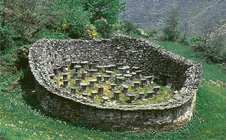Galicia is a Spanish autonomous community located in the northwest of the Iberian Peninsula, formed by the provinces of A Coruña, Lugo, Ourense and Pontevedra. The region spreads out over a total of 29,575 square kilometres and has a population of 2,794,516 inhabitants (data from the Galician Statistics Institute, 2011), located mainly along the coast (in the cities of A Coruña, Vigo, Ferrol and Pontevedra). The most frequent population systems are rural and scattered around the territory.
The Galician Statute of Autonomy was ratified in 1981, recognising Galego as the official language of Galicia and the co-official language of the community together with Spanish, which “everyone is entitled to know and use.” The Statute also entrusted the political powers with promoting its normalisation in all spheres of life. The Linguistic Normalisation Act, passed unanimously on 15 June 1983 in the Galician Parliament, develops these principles in the Preamble in the framework of “a constructive effort geared towards reclaiming our collective personality and its creative potential.”
Over almost 20 years, several complementary decrees, orders and regulations have been passed to secure the legislative framework and the recuperation of the Galician language, its social use and its promotion in a range of spheres (Administration, education, media, etc.), as well as to establish the Galician toponymy as the official place names.
The Galician language is spoken in the Autonomous Community of Galicia and in the westernmost areas of Asturias, León and Zamora, as well as in small pockets of Extremadura. Furthermore, given the historical emigration of Galicians around the world, a number of linguistic communities preserved Galego as their language of choice in cities such as Barcelona, Zurich, Montevideo and Buenos Aires.
Galego belongs to a family of Romance languages, as is the result of the evolution of Latin, which was brought into the area by the Romans in the northwest of the Iberian Peninsula. Already in the 9th century, the language spoken in this area differed so much from Latin that they could be considered two different languages. Galego was once the language used for lyric poetry in the whole of mainland Spain. The proper name is Galician-Portuguese lyric poetry, since both languages constituted a linguistic branch until the mid-14th century.
The Galician language is used by most of the population and is spoken by 55.42% of the population –according to data from the latest living standards survey, carried out in 2008 by the Galician Statistics Institute.

Today we enjoy a varied and dynamic culture, based on tradition, but which has gradually incorporated contemporary languages. The fact that this land is home to the final destination of a pilgrimage route that has formed the backbone of European culture meant that throughout the Middle Ages it acted as a natural magnet for European trends in art and thinking. Contact with other European Atlantic nations also flourished. From the first half of the 20th century onwards, the emigrants that set sail from Galicia to America also played an important role in enhancing Galician culture.
Galician culture today enjoys solid foundations, with an increasingly consolidated cultural and creative industry, which represents a strategic sector for Galicia’s social and economic development.
One of Galicia’s premier cultural institutions is the City of Culture of Galicia, located in Santiago de Compostela. Galicia’s main official cultural and linguistic institutions are the Galician Council for Culture and the Galician Royal Academy, founded in 1906. Galicia’s three universities also play a major role in the cultural development of the region.
Galician culture has several challenges on the horizon, including the conservation and promotion of the social value; the creation of a new policy for the dissemination of artistic, linguistic and cultural manifestations; and institutional support to enhance the competitive quality of the cultural industry.

Galicia’s cultural heritage is characterised by its abundance, variety and geographical dispersion, as well as by its capacity to blend into its setting. There are numerous megalithic monuments, including cave drawings and castros (fortified settlements), and the land is also rich in Roman ruins, most notably the Walls of Lugo and the Tower of Hercules in A Coruña, both listed as UNESCO World Heritage Sites. Galicia is recognised throughout Europe for the multiple routes to Santiago de Compostela, listed by the UNESCO as a World Heritage City.
The ultimate destination of the Way of St. James is the cathedral of Santiago de Compostela. This symbol of Galicia has played a historical role in building a European identity.
With more than 30,000 settlements, the population has shaped the Galician landscape. The main architectural heritage are granite religious constructions. The most notable examples of Galician ethnographic heritage are the numerous hórreos –granaries that are raised off the ground– and the cruceiros –stone crosses that normally stand at crossroads.
Galicia also boasts a splendid oral culture that has played an essential role in keeping traditions and customs alive for centuries, and has passed down through generations a collective memory and a language that was shunned by high culture and political power for a long time.